calsfoundation@cals.org
Mammoth Spring
Mammoth Spring is the largest spring in the state of Arkansas, the second largest in the Ozark Mountains region, and the seventh largest in the United States. This National Natural Landmark is located within the boundaries of Mammoth Spring State Park. Approximately 497 feet from the Missouri state line in north-central Arkansas, it is within sight of U.S. Highway 63 and the city of Mammoth Spring (Fulton County). Though the spring has always been known as “big” or “mammoth,” the first known settlers in the 1820s created a small village called “Head of the River,” which would later be renamed Mammoth Spring.
Water flows from the spring at an average rate of 9.78 million gallons per hour, with a constant water temperature of fifty-eight degrees Fahrenheit. It measures eighty feet deep at the head of the spring; twenty feet of that is a vertical underwater bluff. Though the actual spring cannot be seen from the surface because of the depth of the pool, it resembles a funnel with a bent tube featuring a forty-five-degree angle. The water from the spring forms a ten-acre lake known as Spring Lake and flows south as the Spring River, one of state’s best-known rivers for trout fishing and recreational floating.
A spring is a natural flow of water that serves as an outlet for water that has accumulated in the permeable rock strata underground. Rainwater soaks into the soil and is drawn downward by gravity into openings, or fractures, in the limestone, in the process forming underground channels or caves. Once these spaces have become completely saturated with water, an outlet must be found, leading to the formation of a spring. Local folklore regarding the creation of Mammoth Spring includes the tale of a Native American tribe that was suffering through a great drought. The chief’s son died, and in a fit of despair the chief executed the tribe’s warriors. As a mass grave for them was dug, water gushed forth from the ground, thus forming Mammoth Spring.
Rainwater from the high, flat plateau areas in southwestern Missouri, from Thayer north to Pomona, is the water source for Mammoth Spring. The rainwater soaks down through the clay soils and fractured limestone deposits until it reaches the underground water table. From there, it flows along a vast underground system of interconnected cavities, eventually converging into a main artery that emerges in the spring pool at Mammoth Spring. At times, the spring pool is noticeably bubbly, a condition attributed to the high levels of minerals such as calcium and magnesium.
As a bottom-fed spring, Mammoth Spring supplies a consistent level of water year round to both Spring Lake and the Spring River. Because of the cool temperature and steady water supply, two fish hatcheries are located near the spring to provide fish for stocking the Spring River. The first of these is the oldest national fish hatchery in Arkansas, the Mammoth Spring National Fish Hatchery (MSNFH), which was established in 1903 and is operated by the U.S. Fish and Wildlife Service. In addition, the Jim Hinkle Spring River State Fish Hatchery is operated by the Arkansas Game and Fish Commission.
For additional information:
Mammoth Spring State Park. http://www.arkansasstateparks.com/mammothspring/ (accessed October 27, 2021).
U.S. Geological Survey Data from the Mammoth Spring Gauging Station. waterdata.usgs.gov/ar/nwis/uv/?site_no=07069190&PARAmeter_cd=00065,00060 (accessed October 27, 2021).
Dianna Owens Fraley
Couch, Missouri
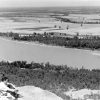 Geography and Geology
Geography and Geology Karst Topography
Karst Topography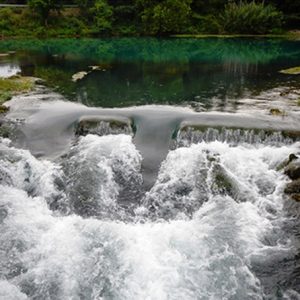 Mammoth Spring
Mammoth Spring 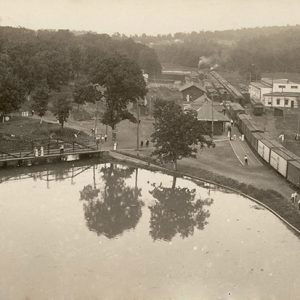 Mammoth Spring Depot
Mammoth Spring Depot 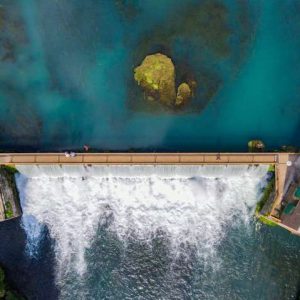 Mammoth Spring Spillway
Mammoth Spring Spillway 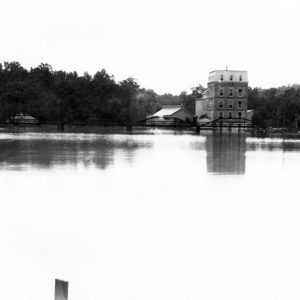 Mammoth Spring State Park
Mammoth Spring State Park 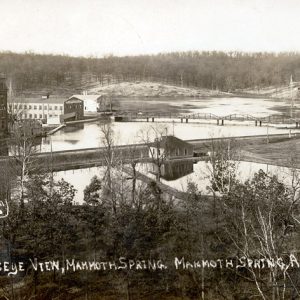 Mammoth Spring
Mammoth Spring 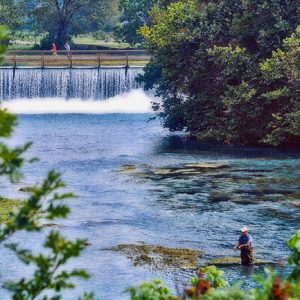 Mammoth Spring State Park
Mammoth Spring State Park 



Teenagers sometimes show very poor judgement and that was the case with me at age fifteen, during the summer of 1971, after receiving a scuba certification from a local Mammoth Spring dive instructor. Mr. Ray Parker, an experienced Navy diver, warned his students not to attempt to dive Mammoth Spring. He stated that the spring wall was crumbly, with poor water clarity at depth, which would make the dive very hazardous.
My dive partner Neal Backman, also of Mammoth Spring, assisted me in preparing a large inflated inner tube with a long safety line for the dive. Fifty-eight-degree water required full wet suit use. The descent down the safety line started at the head of the spring and quickly became very dark at around 25 feet. From that point, descent was down the slanting wall or cone of the spring. Some have said that the spring is around 80 feet deep; however, my descent was halted by the force of the water emerging from under the mountain at 110 feet, according to my depth gauge. Visibility was limited to only a few feet, and I clearly recall in the beam of my dive light, small, polished rocks swirling in the current at the bottom.
My ascent was not uneventful. As I followed the safety line toward the surface, I did not realize that I had moved under an angled bluff during my descent. I struck my head against the bluff wall and would not have known which direction to go to the surface, had it not been for the safety line. After pulling myself from under the bluff wall that apparently created a cone, the rest of the ascent was uneventful. An interesting and dangerous experience that will never be forgotten.
Arkansas State Parks put the spring off limits to divers sometime during the 1970s and with good reason.
In the fall of 1966, while I was a student at Memphis State University in Memphis, Tennessee, a friend of mine and I scuba dived into the Mammoth Spring pool in an attempt to penetrate the spring itself. We did manage to get to the opening of the spring at about eighty feet deep, but the force of the water was so tremendous, we could get no farther than the opening at the base of the vertical rock wall in the northwest corner of the spring pool next to Hwy. 63. I remember the visibility was only about three or four feet, even with powerful diving lights. I remember seeing gravel on the bottom literally boiling from the force of the water. I lost a diving knife somewhere in the pool that day and I presume it’s still down there. I look back on that attempt as a foolhardy adventure of youth and hope no one ventures into that dangerous place again. Once was enough for me.